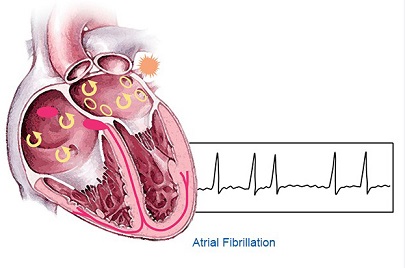Medical News: Researchers Claim That Fibrinaloid Microclots Could Be Behind Atrial Fibrillation! Relevant For SARS-CoV-2 Context!
Nikhil Prasad Fact checked by:Thailand Medical News Team Jan 29, 2024 1 year, 11 months, 3 weeks, 2 days, 8 hours, 20 minutes ago
Medical News: Atrial fibrillation (AF) stands as a prevalent heart arrhythmia with significant implications for global health. Recent findings from various academic institutions, including the University of Liverpool (UK), Technical University of Denmark, Stellenbosch University (South Africa), Liverpool Heart & Chest Hospital (UK), and Aalborg University (Denmark), shed light on a potential connection between fibrinaloid microclots and the development of AF. This revelation carries paramount importance, especially in the context of SARS-CoV-2, the virus responsible for COVID-19.
 Fibrinaloid Microclots Could Be Behind Atrial Fibrillation
Understanding Atrial Fibrillation
Fibrinaloid Microclots Could Be Behind Atrial Fibrillation
Understanding Atrial Fibrillation
AF, characterized by irregular atrial electrical activation and ineffective atrial contraction, has been linked to various chronic, inflammatory diseases. Clot formation within the atrial chamber is a well-known consequence of AF, contributing to mortality and morbidity from strokes and coronary heart disease. The intricate relationship between AF and other comorbidities, such as infection and air pollution, has prompted researchers to delve deeper into the potential role of fibrinaloid microclots in the development of AF.
Fibrinaloid Microclots: A Closer Look
Fibrinaloid microclots, ranging in size from 2-100 mm, have been observed in plasma or serum and are associated with chronic, inflammatory conditions. These microclots, characterized by an amyloid nature, exhibit resistance to fibrinolysis, contributing to their persistence in circulation. The formation of fibrinaloid microclots is catalyzed by external stimuli, including bacterial cell wall substances and the SARS-CoV-2 spike protein. These microclots, once formed, have been found to induce cytotoxic effects, including hypoxia/reperfusion.
Thailand
Medical News would like to add that since the COVID-19 mRNA vaccines also use the SARS-CoV-2 spike proteins and are actually able to also cause the production of the spike proteins, there is a very high possibility that it is also causing the formation of fibrinaloid microclots that in turn are possibly causing atrial fibrillation in many.
Decoding Fibrinaloid Microclot Formation
To understand the potential role of fibrinaloid microclots in AF, it is crucial to explore the mechanisms behind their formation. Soluble fibrinogen, a key player in clot formation, undergoes polymerization to fibrin in the presence of the serine protease thrombin. Early electron microscope studies revealed that fibrin fibers in chronic, inflammatory conditions exhibited anomalous conformations, referred to as "dense matted deposits." These abnormal fibers, induced by factors like free iron, were later identified as amyloid in character, resistant to proteolysis.
Associative Evidence and Risk Factors for AF
Modern analytics in medicine often revolves around identifying risk factors, and AF is no exception. While certain factors like age, gender, and BMI are associated with AF, it is essential to explor
e the potential link between these factors and fibrinaloid microclots. Lifestyle choices, such as alcohol consumption and exposure to particulate matter, also play a role in AF, further emphasizing the need for a comprehensive understanding.
Comorbidities and Infections
Chronic, inflammatory diseases share common features, including inflammation, oxidative stress, and iron dysregulation. The presence of fibrinaloid microclots in these diseases raises the question of a shared underlying cause. Infections, particularly viral and bacterial, emerge as key players in AF development. Notably, infections like community-acquired pneumonia and SARS-CoV-2 have been linked to new-onset AF. Long COVID, a post-infection syndrome, also shows an increased likelihood of AF. The interplay between infections, fibrinaloid microclots, and AF suggests a complex relationship that warrants further investigation.
Conclusion and Future Perspectives
In conclusion, the emerging evidence suggests a significant role for fibrinaloid microclots in the development of atrial fibrillation. This insight has profound mechanistic and therapeutic implications, paving the way for a more comprehensive understanding of AF and potential novel treatment approaches. Future research should prioritize investigating the independent role of fibrinaloid microclots as a risk factor for AF, potentially reshaping our approach to this prevalent heart arrhythmia.
The study findings were published on a preprint server and are currently being peer reviewed.
https://www.preprints.org/manuscript/202401.1945/v1
For the latest
Medical News, keep on logging to Thailand
Medical News.
